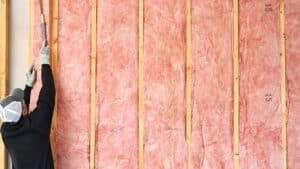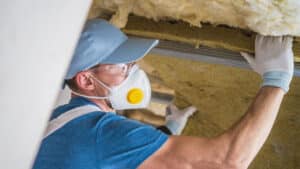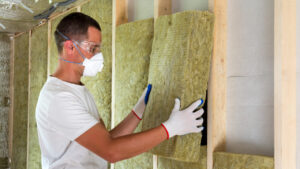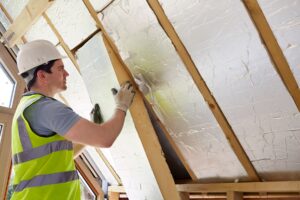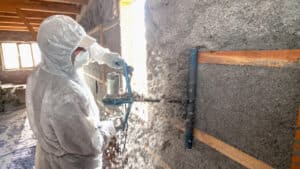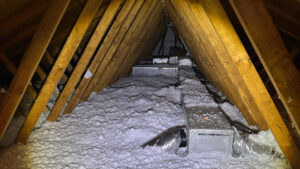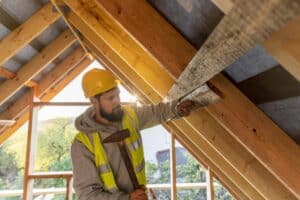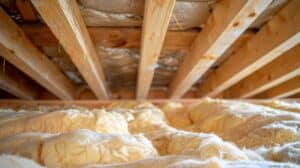With winter around the corner many homeowners are starting to take a hard look at their home’s ability to insulate. One of the most popular materials for this task is fiberglass attic insulation.
This material is a very popular choice because of it’s eco-friendly construction and strong insulating properties. It is essentially made from bits of glass. It’s used in many different products including homes and automobiles. It essentially works by trapping air and acting as a non-permeable barrier so heat or cold stay on one side and not the other. As an insulation contractor we like how fiberglass helps our customers lower their energy bill.
Yet, understanding its advantages, potential concerns, and proper usage is worth understanding for homeowners looking to make informed decisions about how to invest in their property.
With winter approaching, many homeowners are checking how well their homes keep in the warmth. Fiberglass attic insulation is a common choice for this job.
This material is popular because it’s eco-friendly and has good insulation properties. It’s basically made from bits of glass and is used in various things like homes and cars. It works by trapping air and creating a barrier so that heat or cold stays on one side and doesn’t pass through. As insulation contractors, we appreciate how fiberglass helps our customers reduce their energy bills.
However, it’s important for homeowners to understand its benefits, potential issues, and how to use it properly when deciding how to invest in their property.
What are the Benefits of Fiberglass Attic Insulation?

Fiberglass insulation is a smart choice for a cozy and budget-friendly home. It’s not too expensive and comes in sheets called ‘batts’ as well as in a loose fill form. Batts come in different thicknesses offering different level of insulation denoted by the R-Value. Having sufficient enough insulation is what lowers the amount of effrot A/C and heating units need to run to keep a space the proper temperature. The result for a homeowner is always low energy bills but also reduced noise between rooms.
Let’s dive into the simple yet powerful benefits that make fiberglass insulation a top pick for homeowners and builders alike:
Cost-Effective Insulation Solution
Relative to other insulation types fiberglass insulation offers a cost-effective option for homeowners to improve their home. It offers robust R-Value options and thermal conductivity which contribute to potential long-term energy savings, (10 to 20 years). With the capacity to reduce heating costs and cooling bills by 40% to 50%, it proves to be an economical choice.
Noise Reduction Capability
Fiberglass insulation exhibits excellent acoustical properties, effectively absorbing and blocking sound waves to diminish noise transmission through walls or ceilings. Widely utilized in commercial and industrial settings, its noise-blocking effectiveness depends on factors such as density, thickness, and installation method.
Environmentally Friendly Material
Crafted from recycled glass, fiberglass insulation can be recycled after use. While previous manufacturing processes involved formaldehyde, many manufacturers have transitioned away from this toxic chemical. Modern production methods emphasize eco-friendly practices which contribute to lower carbon emissions.
Flexible Installation Process
Homeowners and contractors find fiberglass to be one of the more flexible insulation types. Whether cutting insulation batts to fit specific spaces or using a blowing machine for loose-fill insulation, the installation is malleable enough in shape to fit crawlspaces of different sizes and dimensions in one of the various forms such as batts, rolls, loose-fill, or spray.
Resistance to Mildew and Mold
Naturally resistant to mold thanks to its glass composition the fibrous material may retain moisture, potentially leading to condensation issues. This can be mitigated by opting for faced insulation, where one side is covered with a moisture-absorbing paper product to safeguard it from potential water damage.
7 Facts About Fiberglass Attic Insulation that are Worth Knowing

Let’s explore the details of this essential insulation choice and discover how it becomes a cornerstone for any energy-efficient and serene home.
1. Fiberglass Has Good R-Values
R-values is a measurement that indicates an insulation material’s resistance to heat flow. The range usually goes up to R30 but usually ranges from R11 to R19 for wall insulation. Fiberglass insulation comes in various R-Values as diverse as the forms of insulation. It can boast significant R-values, ensuring your home is well-protected against temperature extremes.
Typically it’s recommended that you have a higher R-Value in the attics or crawl spaces and lower R-Values in your wall insulation and more daily living spaces. Since R-Value is great resistance to conduction it makes sense to have thicker R-Value Fiberglass in the areas most exposed to your house: your exterior walls, attics, etc.
2. Fiberglass is Fire-Resistant
Fiberglass provides a robust line of defense against fire. Its composition is inherently fire-resistant, making it a bad fuel source for fires.
Your choice of fiberglass insulation adds a crucial layer of protection: its non-combustible nature means a lower risk of fire spreading should an incident occur. You gain not just effective thermal regulation but also a crucial fire deterrence within your attic space.
– Non-combustible nature reduces fire risk.
– Does not contribute to flame spread in case of fire.
– Offers both insulation and a protective fire barrier.
3. Fiberglass Can Be Blown-In
Transforming your attic with blown-in fiberglass is an efficient process that can drastically enhance energy efficiency. You’re choosing a method that allows for comprehensive coverage, especially in the hard-to-reach nooks and crannies of your attic space.
Blown-in fiberglass has the unique advantage of filling in irregularities, ensuring a tight seal that minimizes air leaks. This technique is crucial for historic homes or unique architectural designs, saving you money on heating and cooling costs over time.
4. Fiberglass is Long-Lasting
When you invest in fiberglass, you’re opting for a solution known to endure the test of time. Because the main element is glass, it does not rot easily and enjoys a long shelf life. Often fiberglass insulation maintains its original R-Value for decades without significant deterioration, ensuring you won’t have to revisit your insulation needs frequently.
Unlike other materials that may settle or degrade, fiberglass retains its shape and effectiveness, providing a constant thermal barrier in your attic space. Its longevity makes it a cost-effective choice, as the initial installation of insulation contractors continues to pay dividends in energy savings year after year.
5. Fiberglass Has Soundproof Capabilities
Fiberglass comes with a lesser-known benefit: its sound-dampening properties that contribute to a quieter home environment. The air trapped by the small glass particles stops the vibrations of sound from passing through. By absorbing sound waves, this versatile material can help reduce the intrusion of exterior noise, so you can enjoy a calm and serene living space.
Its dense composition not only keeps your home thermally regulated but also acts as an acoustic barrier, effectively dulling noises such as traffic, airplanes, and nature’s elements. This feature is particularly beneficial if you’re working from home or have a room dedicated to audio-sensitive activities like music or study.
6. Fiberglass has Industry Standards
Fiberglass attic insulation adheres to stringent industry standards, ensuring it meets safety and performance benchmarks. As a homeowner, you gain confidence as this material is rigorously tested and certified to comply with various regulations, such as those set by the American Society for Testing and Materials (ASTM).
When you choose fiberglass, you’re opting for insulation that conforms to the highest quality controls on a national basis. It’s a product backed by seals of approval, signaling its effectiveness in enhancing your home’s thermal efficiency and overall energy performance:
| Industry Standard | Description | Impact on Fiberglass Insulation |
|---|---|---|
| ASTM C665 | Specification for Mineral-Fiber Blanket Thermal Insulation for Light Frame Construction and Manufactured Housing | Ensures the thermal efficiency and material quality of fiberglass insulation |
| ASTM E84 | Test Method for Surface Burning Characteristics of Building Materials | Confirms the fire safety rating of fiberglass, crucial for building applications |
7. Fiberglass It’s Not As Itchy As It Once Was
Gone are the days when working with attic insulation meant a guarantee of itchy skin and irritation. Innovations in fiberglass insulation have led to much more user-friendly products, incorporating finer, less abrasive fibers that significantly reduce the potential for itchiness upon contact.
You can now handle or be near fiberglass attic insulation without the dread of discomfort that was once a given. This advancement not only simplifies the installation process but also makes occasional attic visits less daunting for you as a homeowner.
Is Fiberglass Insulation Toxic?

Over time, fiberglass insulation has gained a somewhat negative reputation due to concerns about its toxicity and potential health risks. However, it’s important to set the record straight. In reality, fiberglass is considerably less toxic than alternatives such as polyurethane spray foam or rigid foam treated with flame retardants. Moreover, it’s far safer than outdated insulation types that once contained harmful substances like formaldehyde or asbestos, both of which are now banned.
By following standard safety precautions, akin to those necessary for spray-in foam insulation, using fiberglass poses no greater risk. The precautions involve simple measures like wearing a protective mask and clothing, a practice common to other insulation types like rockwool or cellulose insulation.
It’s crucial to note that fiberglass is regarded as consumer-safe by the majority of health and safety organizations. So, when handled responsibly, fiberglass proves to be a reliable and secure choice for your insulation needs.
What Are the Dangers of Fiberglass Insulation?

As you explore the world of attic insulation, it’s important to assess the potential risks associated with fiberglass. Despite its widespread use and efficiency, you should be aware that improper handling of fiberglass insulation can lead to discomfort or irritation. The fine glass fibers may irritate sensitive skin, eyes, and respiratory tract if not managed carefully during installation.
Another risk worth considering is that when fiberglass insulation isn’t properly sealed, fibers can sometimes find their way into the air. It’s crucial to ensure installation is meticulously done by professional installers, and barriers like sheetrock and air sealing are securely in place to maintain the integrity of your indoor environment.
Do keep in mind that while fiberglass is non-flammable, the paper or foil backing often used for batt insulation can carry a fire risk if exposed to high temperatures. It’s key to rely on qualified insulation contractors who can install the material in such a way that mitigates any potential fire hazards and complies with local building codes.
Last, long-term exposure to fiberglass particles is something to be mindful of, particularly during renovations or repairs. Be sure to engage skilled contractors who follow safety protocols to prevent unnecessary exposure and preserve the well-being of those within your home.
What Is the Recommended Thickness of Fiberglass Insulation for a Specific Application?

When targeting optimal energy efficiency in your home, understanding the right thickness for fiberglass attic insulation is critical. For most areas, building codes will often specify a recommended R-value, which in turn determines the necessary insulation thickness. For example, in colder climates, you might need an R-value as high as R-49, which could require around 16 to 18 inches of insulation.
Your specific needs can vary based on several factors, including the age of your home and differences in the climate zone, the current state of your home’s insulation, and whether you’re adding new insulation over an existing layer. Expert installers will assess these aspects to ensure that the correct thickness of wall insulation is applied, aligning with your home’s requirements and regional energy codes.
It’s important not to overlook the manufacturer’s specifications as well. Fiberglass batts come in various thicknesses and are designed to fit between the joists and studs of your home. Choose a thickness that maintains its intended R-value without being compressed, as this can significantly diminish its insulating properties.
Get Fiberglass Attic Insulation for Your Home Today

When it comes to enhancing your home’s energy efficiency, the installation of fiberglass attic insulation is a decision that pays off in spades: both in comfort and in cost savings. By choosing to insulate your attic, you’re making a commitment to an environmentally-friendly and economically sensible improvement. Fiberglass, with its high R-values and fire resistance, is your ally in this upgrade.
– Dive into the world of energy savings with professionally installed fiberglass attic insulation.
– Feel the swift impact on your energy bills as fiberglass insulation impedes unnecessary heat flow.
– Embrace the tranquility fiberglass brings with its sound buffering abilities.
– Enjoy peace of mind knowing the fire-resistant qualities of fiberglass add a safety layer to your home.
With your home under the protective layer of fiberglass insulation, you can now confront extreme temperatures confidently, knowing your living space is effectively shielded against water damage. The comfort you gain is not limited to temperature alone; fiberglass serves as a barrier against the ingress of unwanted sounds, creating a more serene environment.
The safety benefits cannot be understated either. Fiberglass’s inherent fire-resistant properties bolster the security of your home against potential fire hazards. Universal Installation Doctor skillfully install your insulation solution, they ensure that your attic is not just insulated but also made safer.
Frequently Asked Questions
Can fiberglass attic insulation help lower my energy bills?
Absolutely, fiberglass attic insulation is an effective way to reduce energy costs; it works by limiting heat flow and keeping your living space more temperature-stable. Enhanced energy efficiency garnered from proper insulation translates to noticeable savings on heating costs and cooling bills.
What are the potential health risks associated with fiberglass insulation?
Fiberglass insulation, commonly found in many homes, poses potential health risks primarily through inhalation and skin contact. If its tiny fibers are disturbed and become airborne, they can irritate the skin, eyes, and respiratory system, sometimes exacerbating conditions like asthma. Insulation contractors can help address water damage and crawl space issues.
How do I determine the appropriate thickness of fiberglass insulation for my attic?
The appropriate thickness for fiberglass attic insulation largely hinges on your home's location and the specific R-value recommended for your climate zone. Consult a reputable insulation contractor or use the U.S. Department of Energy's guidelines for recommended insulation levels to ensure your attic is properly prepped for both hot and cold weather.
Is it necessary to hire professional installers for fiberglass attic insulation?
Yes, hiring professional installers for fiberglass attic insulation is highly recommended due to the complexity of the installation process and potential health risks from improper handling of materials. Professionals ensure the insulation is installed correctly, maximizing energy efficiency and safety in your home.
Can fiberglass insulation be used in other areas of my home besides the attic?
Absolutely, fiberglass insulation is versatile and suitable for various parts of your home including walls, crawl spaces, and basements to enhance energy efficiency and comfort. It's not just for attics; its application in other areas can significantly reduce heat flow and energy costs.

